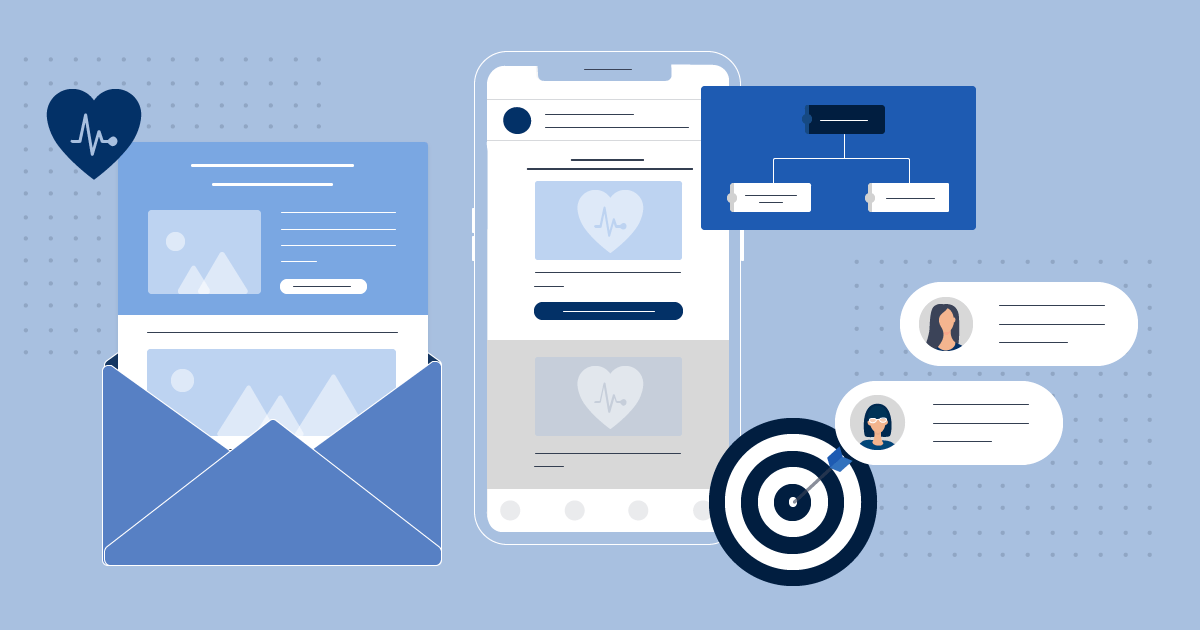
The Ultimate Guide to Healthcare Email Marketing [2025]
Email might not be the newest channel, but for healthcare brands, it’s proving to be one of the most effective ways to reduce no-shows and keep patients engaged.
That’s because while your team is stuck on hold or buried in paperwork, a well-timed email can do the heavy lifting, delivering the right information without adding to the chaos. And we’re not talking about one-size-fits-all blasts. We mean appointment reminders that work, follow-ups that show you care, and wellness tips your audience looks forward to.
But that’s just the beginning of what email marketing can do for healthcare businesses.
In this guide, we’ll explore what healthcare email marketing is, its benefits, and how it differs from other industries. We’ll also walk through essential campaign types, real examples, and the tools that make it all possible.
The doctor is in… your inbox.
Deliver personalized patient communications with powerful email automation.
Try MoosendWhat is Email Marketing for the Healthcare Industry?
Email marketing for healthcare is a way for medical professionals, clinics, hospitals, and health-related businesses to stay in touch with patients and clients through email.
Instead of relying only on phone calls or printed letters, healthcare providers can use email to quickly reach people with updates, health tips, or important alerts.
For example, a dental office might email patients to remind them of their upcoming appointment, while a clinic might send a newsletter about seasonal allergies or flu shots.
Benefits of Healthcare Email Marketing
Let’s say a group of patients came in for routine blood tests. In the past, they’d have to return to the clinic just to collect their results or wait for a phone call they might miss.
Now, clinics give patients the option to get an email the moment their results are ready. They can read it on their phone, forward it to another doctor, or save it and keep a digital record.
That’s just one example of how email marketing makes life easier for both patients and providers.
Apart from that, email can benefit your broader healthcare marketing strategy by:
- Helping patients stay on track: Automated reminders for screenings, check-ups, or medication refills help improve care without adding extra admin work.
- Sharing wellness educational content: Tips on sleep, nutrition, mental health, or seasonal care delivered straight to the inbox can boost patient knowledge and trust.
- Following up after visits: A quick email asking how a patient is feeling or offering next steps can improve their experience with your service and show you care.
- Re-engaging former patients: A friendly email can encourage patients to rebook and reconnect with their provider.
- Supporting preventive care: Outreach campaigns about flu shots, vaccinations, or annual exams encourage action before problems start.
- Making healthcare communication accessible: Emails can be translated, formatted for screen readers, and viewed on any device, helping you reach and support a more diverse patient audience.
Lastly, email is one of the most cost-effective ways to reach patients, offering a high return on investment and increased patient engagement.
How Healthcare Email Marketing Differs from Other Industries
While email marketing follows similar principles across various industries, such as eCommerce or B2B, healthcare email marketing comes with a unique set of needs and responsibilities.
If you want to get it right, you first need to get yourself familiar with them because this isn’t (only) about sending the right message to the right person.
Privacy matters more
Healthcare emails often involve personal health details or appointment information.
That means they need to follow strict privacy rules, such as HIPAA in the U.S. Unlike promotional emails, which can be full of flashy sales, healthcare emails must be trustworthy and confidential.
Even something as simple as a reminder email needs to be written and delivered in a way that protects patient information. Also, you can’t include personal diagnoses or private records unless you have the right tools and consent in place.
Trust over sales
In retail or B2B, the goal is usually to sell a product or service. In healthcare, the main goal is to establish trust. As patients want to feel supported, your emails should focus on being helpful, educational, and respectful.
If you do need to promote a new service or product, it’s better to highlight how it’ll help them reach their goals.
For example, present the benefits for the patient, such as how your product or service can improve their well-being, save time, or make care more accessible.
Reassuring and relevant content
Healthcare topics can be sensitive, emotional, or even scary for some people. Unlike sales email copy, healthcare emails should be supportive and easy to understand.
Imagine a patient receives an email with a subject line like “Important Notice About Your Condition.” Even if it’s a routine update, the wording could cause unnecessary stress.
That’s the kind of anxiety healthcare emails should avoid.
Different timing and triggers
Emails are often triggered by actions like signing up for a trial, abandoning a cart, or downloading a resource. In healthcare, though, timing is more personal and patient-centered.
For example, if a patient hasn’t scheduled their annual check-up, you might send a gentle reminder: “We noticed it’s been a while since your last visit. Let’s get you back on track.” Or after a visit, you could follow up with helpful next steps or recovery tips.
The goal is to stay helpful and relevant at every stage of the patient’s journey.
Accessibility and design requirements
Patients vary widely in age, ability, tech-savviness, and even their preferred method of reading information. That’s why healthcare emails need to be easy to read and navigate for everyone.
Small fonts, busy layouts, and hard-to-click buttons can frustrate or even exclude readers, especially older patients or those using assistive devices. A clean, mobile-friendly design with large text, clear headings, and simple calls to action (CTAs) makes a big difference.
Healthcare Email Marketing Trends
The way healthcare organizations use email is changing fast. Now, it’s all about smarter, safer, and more inclusive communications, tailored to each patient. And, of course, artificial intelligence (AI) couldn’t be absent from the list.
Here are some of the trends you should keep in mind:
- Hyper-personalized messages: AI-powered personalization makes emails feel more like conversations than campaigns, tailoring send times, subject lines, and content to each patient’s history.
- More privacy-first strategies: With HIPAA and GDPR in play, marketers are leaning into clean opt-ins, encrypted platforms, and privacy-conscious messaging.
- Mobile-optimized design: 61.9% of email opens come from mobile devices, making it clear that most patients read emails on their phones. Thus, quick-loading and easy-to-read layouts are a must.
- EHR and patient portal integration: Email tools now sync with Electronic Health Records (EHR) and patient portals to automate follow-ups, send test results, and support care plans.
Types of Healthcare Email Marketing Campaigns with Examples
There are many ways to utilize email in healthcare, but certain campaign types are more crucial than others.
Let’s take a look at the most popular and effective types of emails that healthcare providers should prioritize. Also, each one includes a real-world example to show you how it works in practice.
1. Double opt-in confirmation email
A subscription confirmation email ensures that the person signing up genuinely wants to receive your emails, helping you stay compliant with privacy regulations like GDPR and HIPAA.
It also reduces fake signups, protects patient data, keeps your list free of spammers, and improves deliverability rates.
Here’s a simple example from Bayer.
Subject line: [Action Required] Confirm your subscription
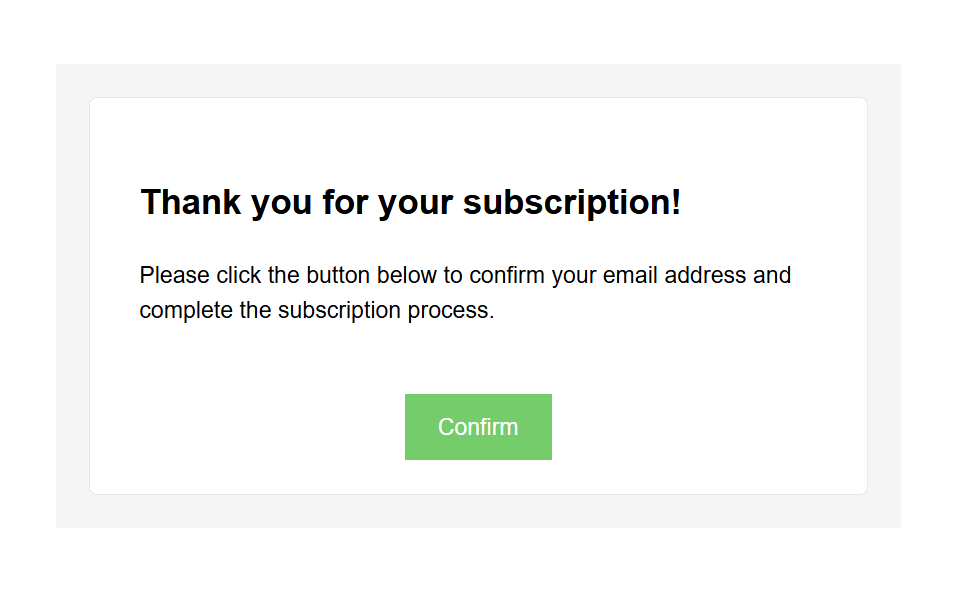
What works:
- The subject line and headline convey the intent right away.
- Copy is short and explains what the reader needs to do next.
- The green “Confirm” button prompts action.
- The minimalist design is ideal for mobile devices.
Always explain why confirmation is needed. This sets the tone for a transparent communication exchange going forward.
2. Thank you for subscribing
These emails are sent right after someone successfully gets access to your platform, portal, or newsletter content.
In healthcare, you can send this email after your new subscriber completes your newsletter signup process, regardless of being single or double opt-in.
Healthy Children delivers a personalized confirmation email to new subscribers right after they register.
Subject line: AAP Healthy Children Registration
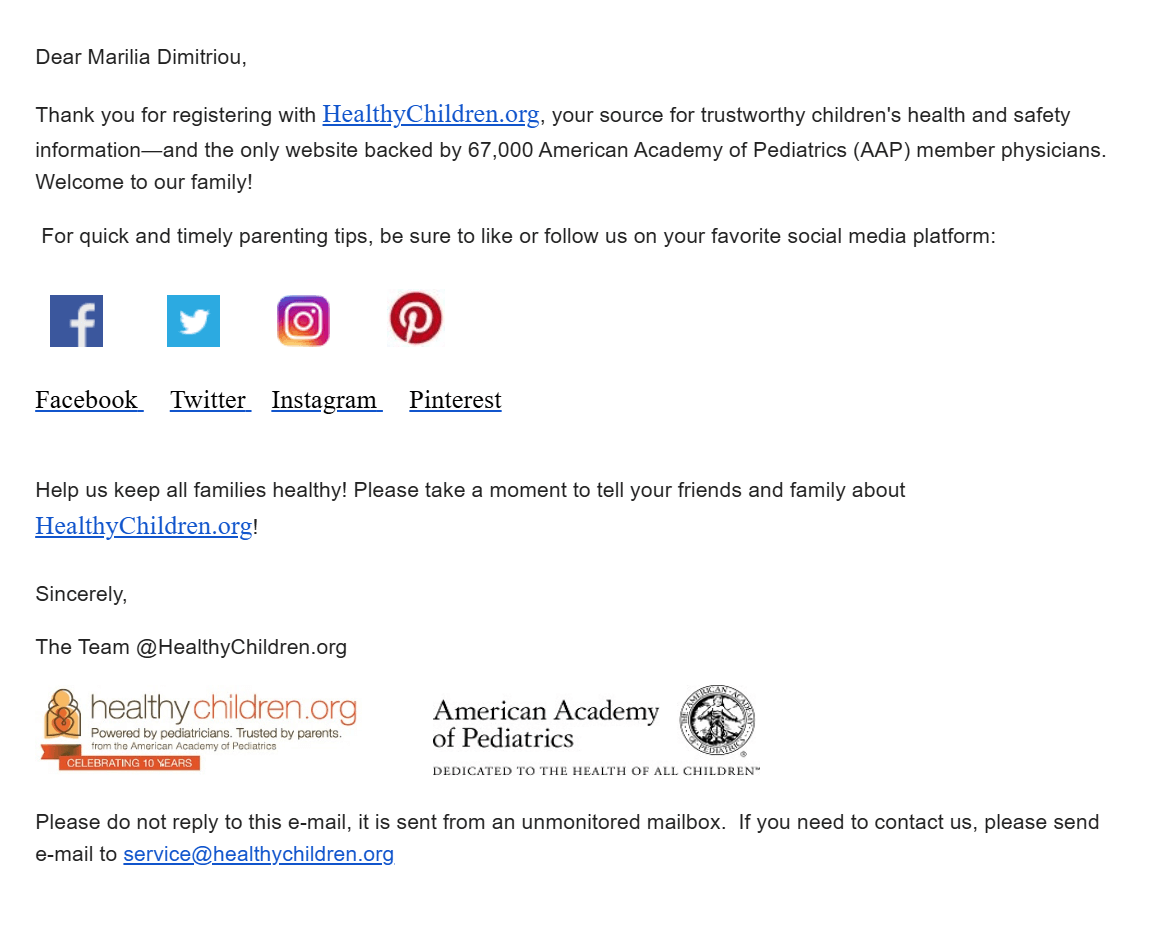
What works:
- Uses the subscriber’s name for a personal touch.
- Highlights that the site is backed by 67,000 pediatricians for credibility.
- The copy is friendly and reassuring with a warm “Welcome to our family” line.
- Encourages readers to stay connected across platforms.
- Invites recipients to share the site with others.
- Provides an email address where they can reach out for help or questions.
3. Welcome email message
A welcome email is your chance to make a strong first impression. Once a subscriber confirms their email or registers, this is the message that explains what they’ll get from staying connected with you.
Welcome emails differ from confirmations and thank-you messages, as they are meant to introduce your brand and set expectations.
Let’s see an example from P&G’s email newsletter.
Subject line: Welcome to P&G The Science Behind
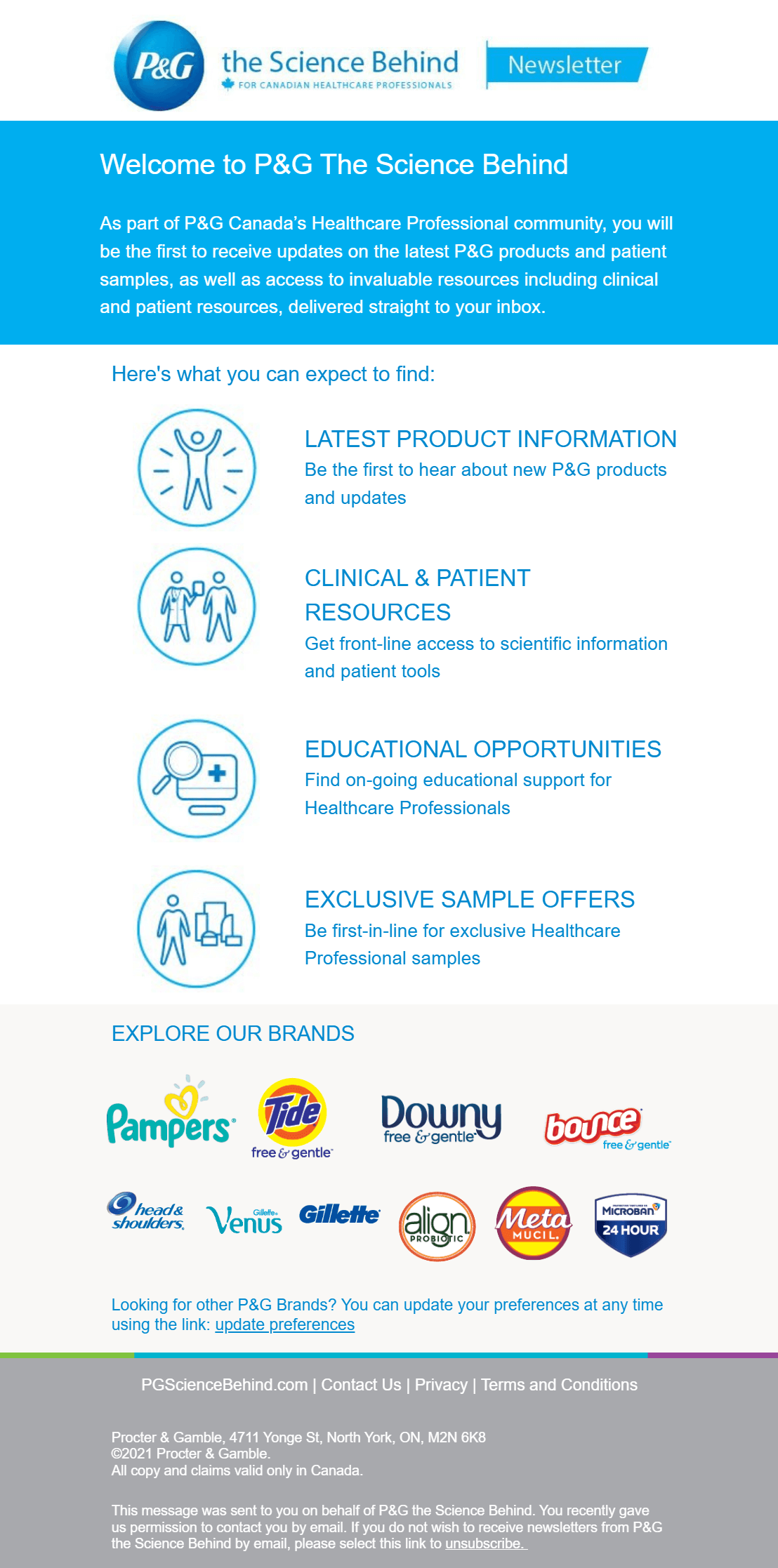
What works:
- The “Welcome to P&G The Science Behind” message is clear and friendly.
- It clearly outlines what subscribers can expect, including product updates, clinical resources, and samples.
- Shows familiar brand logos (like Pampers, Gillette, Tide) to connect the healthcare focus with trusted household names
- Includes links to update preferences, contact, and unsubscribe, ensuring transparency and compliance.
Tip: Use visual elements like P&G did, or short bullets to make benefits easy to digest.
4. Educational email campaigns
Educational content helps build long-term trust by providing existing and prospective patients, caregivers, or healthcare professionals with helpful information.
They position your brand as a reliable source of knowledge, helping you raise awareness, encourage healthier habits, and support informed decision-making.
You can send educational emails regularly or align them with health awareness events, product launches, webinars, or new research updates.
Pfizer sends a monthly newsletter called The Breakthrough to share how it drives change.
Subject line: Pfizer’s Impact, AI’s Future, Men’s Health & More

What works:
- The personal greeting sets a warm tone, while the introduction explains the purpose of the email.
- Highlights timely health topics, such as Men’s Health Month and Food Allergy Awareness.
- Includes high-quality content in different formats, such as video series, articles, and health tips.
- It has headlines, images, short text, and bold CTAs to promote readability and further engagement.
- Ends with helpful links and newsletter management options.
5. Appointment confirmations
Another essential healthcare email marketing campaign you need is appointment confirmations.
These transactional messages offer patients peace of mind by allowing them to check their appointment details without needing to call you.
When set up right, they enhance professionalism and reliability without requiring additional administrative effort.
Let’s take a look at a simple appointment confirmation from doctoranytime.
Subject line: Confirmed appointment with Dr. Stefanou
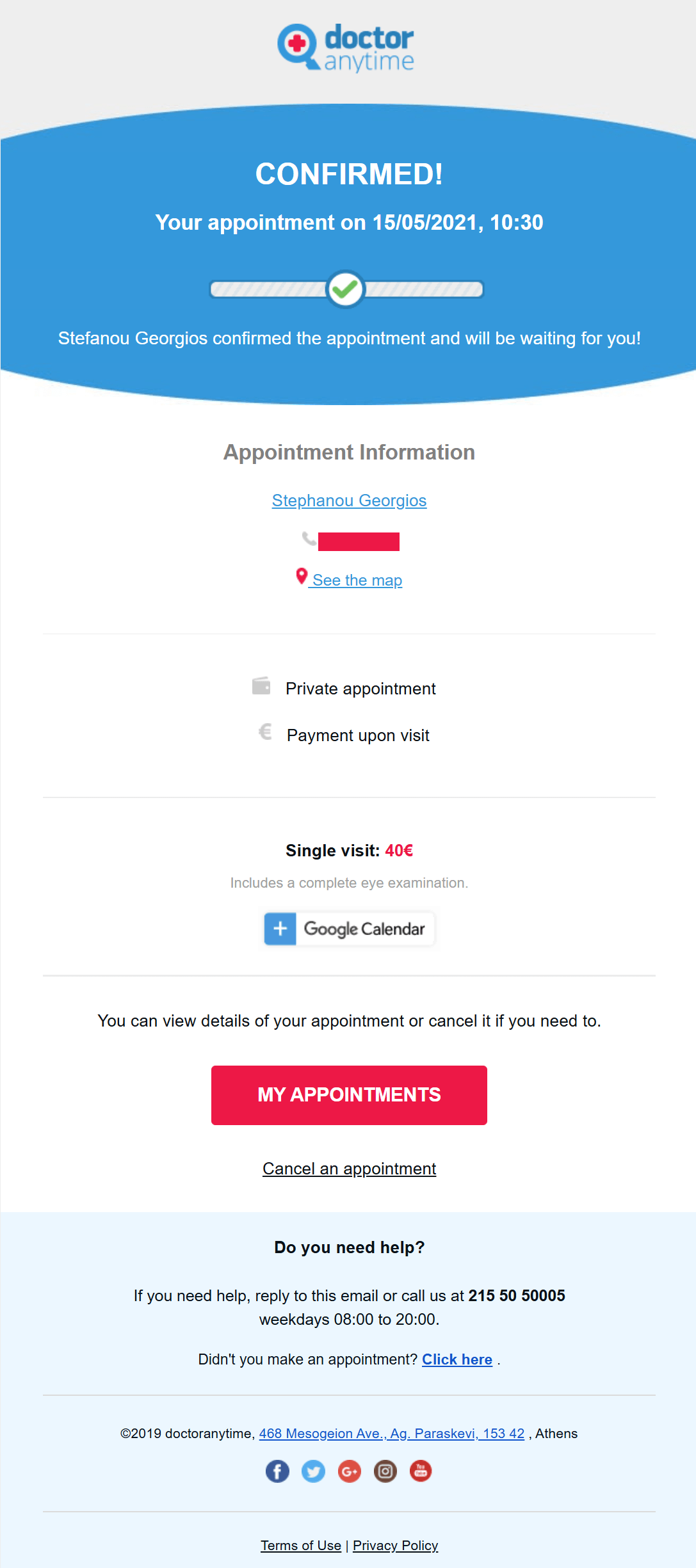
What works:
- The confirmation at the top informs the recipient about the status of their appointment at a glance.
- Includes the patient’s doctor name, time, and appointment type.
- Shows payment method and visit cost with no confusion.
- Offers a location link (See the map) to help avoid missed visits, while the Google Calendar button adds convenience.
- There’s a clear support section for questions or errors.
- The prominent CTA buttons allow recipients to manage or cancel the appointment easily.
6. Appointment reminders
Once a patient confirms an appointment, the next most important thing is making sure they actually show up. Appointment reminder emails are practical tools to reduce no-shows and improve care delivery.
These reminders are especially helpful when patients book days or weeks in advance and may forget. By sending a gentle nudge 24 to 48 hours before the visit, you keep your schedule on track and show patients you’re organized and thoughtful.
For instance, doctoranytime sends this clean, informative reminder email a day before the appointment.
Subject line: Appointment reminder with Dr. Stefanou on 11/02, 10:00AM
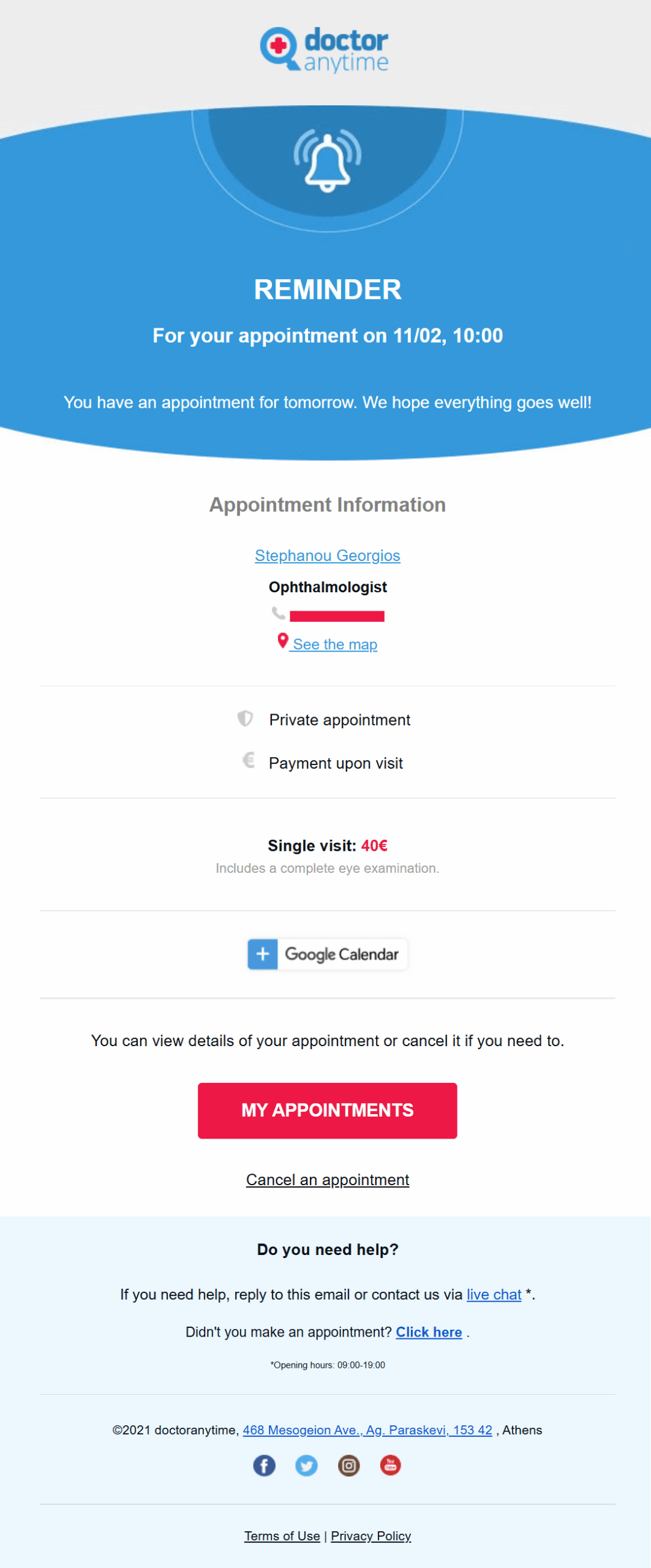
What works:
- The subject line includes all the necessary information the patient needs, including the doctor’s name, medical specialty, appointment date, and time.
- The visual cues (bell icon and “REMINDER” heading) are clear and relevant.
- The “My Appointments” and “Cancel an appointment” links allow patients to see or cancel without having to call the provider.
- The email copy (“We hope everything goes well!”) is reassuring and friendly.
7. Re-engagement campaigns
Even the best patients can become disengaged at times. That’s where re-engagement emails step in. These messages are designed to win back inactive subscribers or patients and remind them of the reasons they initially signed up.
Among other things, these emails are effective because they focus on results, showcase real outcomes, and provide a reason to return.
A great example comes from Parsley Health.
Subject line: The truth about Parsley Health

What works:
- Reminds lapsed users of the brand’s benefits by showcasing stats and results.
- Highlights positive outcomes (97% improved symptoms) to build confidence and spark renewed interest.
- It includes a limited-time offer ($75 off) to incentivize users to return.
- Boosts Parsley Health’s value proposition with both personal messaging and clear data points.
8. Order confirmations and updates
If your healthcare brand ships products, like supplements, prescriptions, or wellness kits, an order confirmation email reassures customers that their order has been received and is in good hands.
These messages should clearly list items, along with their quantities, so customers know exactly what to expect. They also include contact information in case there’s an issue with the order or delivery.
Here’s a healthcare email marketing campaign from Pharmacy295.
Subject line: Order confirmation from Pharmacy295

What works:
- The handwritten-style “thank you” makes it more personal and unique.
- A short note promises care and attention, helping build trust.
- Each product is listed with quantity and image to promote transparency.
- There’s a pricing breakdown, so the customer knows what they paid.
- Easy access to support via email or phone strengthens the brand’s reliability.
- A blog link invites further engagement beyond the transaction.
Tip: Add estimated delivery times or shipping updates to reduce support requests and improve customer satisfaction.
9. Preventive care emails and seasonal outreach
This healthcare email marketing campaign helps brands stay top of mind while positioning themselves as proactive wellness partners.
They provide practical health advice tailored to the time of year, assisting audiences to build healthy habits before issues arise.
For instance, you can send preventive care emails to inform your audience about their annual flu shots or how to handle spring allergies.
Here’s how Tiny Health approaches summer and gut health.
Subject line: What to do (and skip) this summer

What works:
- The tips align with what families typically do in the summer, offering a realistic and relatable scenario.
- Offers additional value through blog content.
- Speaks directly to health-conscious parents searching for solutions for the whole family.
- Uses short copy, colored fonts, and clear visuals to make the email more engaging.
- Concludes with a gentle referral incentive that doesn’t disrupt the flow.
Other healthcare email types to use
In addition to order confirmations and re-engagement emails, here are a few more email types that healthcare businesses can add to their strategy.
- Post-visit follow-ups: Check in after an appointment to review care instructions, discuss prescriptions, and outline next steps. It shows you care for patients on a more personal level.
- Feedback and survey emails: Ask for feedback on visits, services, or delivery experiences. This not only improves care but also shows patients that their voice matters.
- Prescription refill reminders (replenishments): For pharmacies and telehealth services, these keep patients on track and improve retention.
- New service or product announcements: Whether it’s a new test, virtual consult, or supplement, let customers know what’s new and why it matters.
- Social proof emails: Share testimonials, case studies, or success stories to build trust and show real-life results from other patients or customers.
Healthcare Email Marketing Best Practices
Effective healthcare emails should be as helpful and reassuring as possible.
Below, let’s see some simple, effective best practices you can implement in your healthcare email marketing strategy to keep them valuable.
Keep your copy jargon-free
When writing healthcare emails, always aim for simplicity. Your subscribers don’t need medical degrees to understand your message. They need to know what to do next without having to search for complex terms on Google or call you.
Skip the heavy clinical language. Instead, explain things in simple terms that anyone can follow. For example, instead of “dermatological inflammation,” say “skin irritation.”
Plain language improves readability and ensures that every reader, whether they’re a busy parent, a patient with a chronic condition, or someone seeking answers, can take action with confidence.
Write valuable subject lines
A good healthcare email subject line should convey important information at first glance, especially in high-priority emails.
Let’s say you’re sending an appointment reminder. Instead of something vague like “Upcoming appointment,” opt for a straightforward and actionable copy line, as doctoranytime did: “Appointment reminder with Dr. Stefanou on 11/02 at 10:00 AM.”
This example works well because it includes all the necessary information. Even if the recipient doesn’t open the email, they’ll receive immediate value just from the subject line.
Whenever possible, write subject lines that answer the reader’s most immediate questions, like what this is, when it is happening, and why I should care.
Here are some healthcare subject line examples to get inspired:
- Thanks for booking. Here’s what to expect during your visit.
- Missed your visit? Let’s get you rescheduled
- A new health report is available in your account
- Update: Your health info has been securely saved
- From our doctors: Simple tips for better sleep
- Everything you need to know about managing allergies
- How was your visit? We’d love your feedback
- Thanks for your order. Your health items are on the way
Ensure HIPAA and privacy compliance
When sending emails that include patient health data, such as exam results, appointment details, or survey responses, privacy must come first.
For example, Papandreou Medical Services sets a good example by clearly stating that the email is confidential, intended only for the recipient, and that unauthorized sharing is prohibited.

They also offer patients the option to opt out of future electronic communication and inform them of their rights under local data protection laws.
For your healthcare emails, especially those with personal data, be sure to:
- Include a confidentiality disclaimer
- Name the provider or organization clearly
- Offer a way for recipients to opt out of digital communication
- Refer to the applicable data protection law (like HIPAA or GDPR)
- Link securely to surveys or patient portals (never attach sensitive results directly)
This ensures your email communications meet the required standards.
Further reading: Check our email marketing for hospitals guide for more tips.
Segment by patient type
Sending osteoporosis updates to a 22-year-old or acne reminders to someone who booked a hearing test? That’s a quick way to lose trust. Patient-type segmentation helps you avoid that by keeping emails relevant and useful.
One smart way to start is with a topic-based newsletter signup form. Bayer, for instance, lets subscribers choose what they care about, such as Pharmaceuticals, Consumer Health, or Crop Science, so they only receive content that fits their interests from day one.
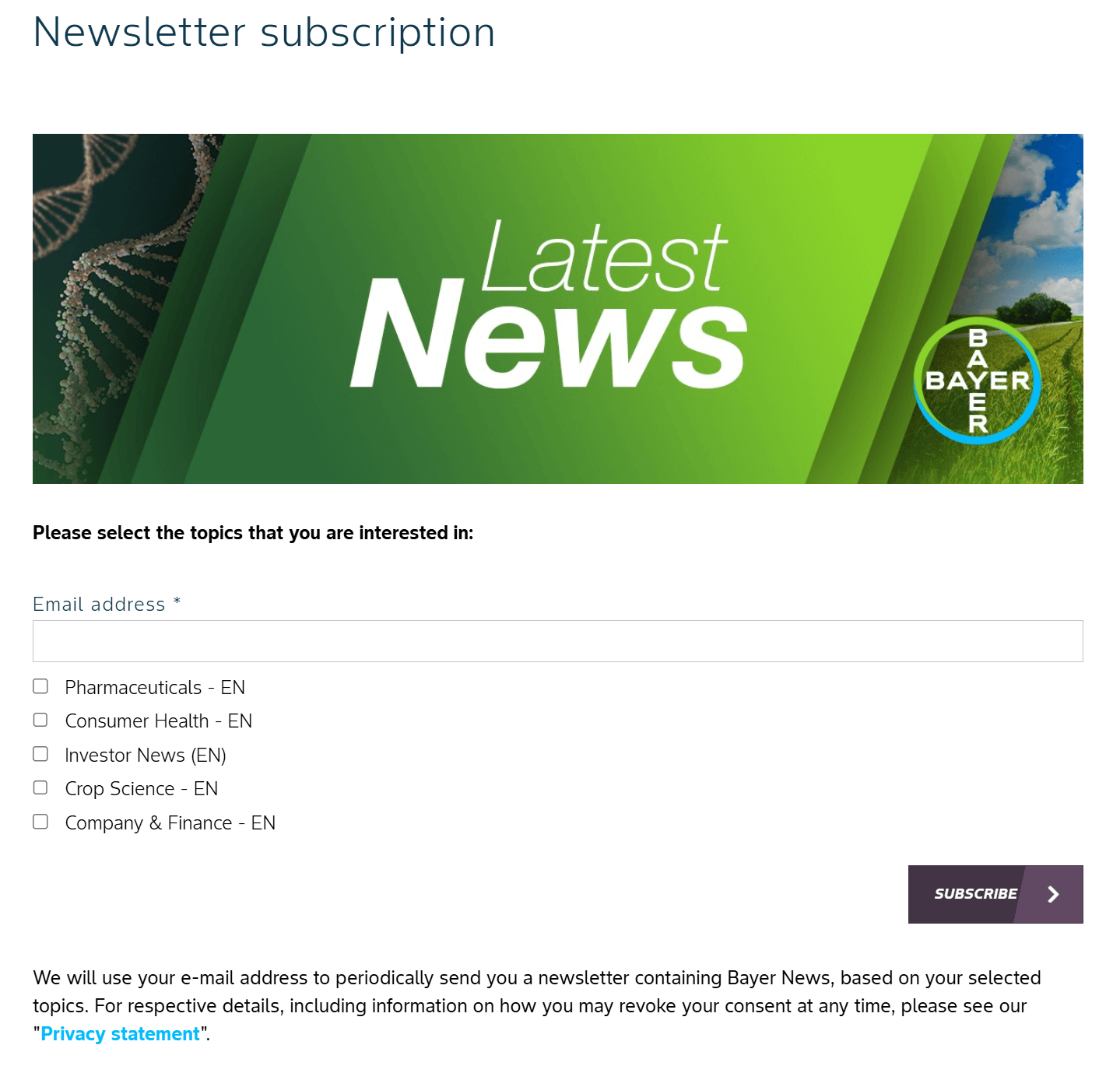
Once someone starts interacting with your brand beyond receiving newsletters, you can refine their segment using data like appointment type (e.g., pediatrics, cardiology), exam results, test orders, or prescription history.
You can also set up a preference center to let subscribers and new patients update:
- Topics they want to hear about
- Their name and birthday (helpful for age-based communication)
- Language preferences
- Contact method (email, SMS)
- Opt out of certain communications
Always go beyond demographic segmentation to ensure your audience receives content tailored to their needs and preferences.
Focus on accessible and responsive design
Everyone should be able to read and interact with healthcare emails, regardless of device or ability.
One way to ensure this is by using pre-made responsive templates like the following, which are already designed with accessibility in mind.
They typically feature a clean, single-column layout, clear CTAs, and mobile-friendly formatting, saving you time while making your emails easy for all readers to engage with.
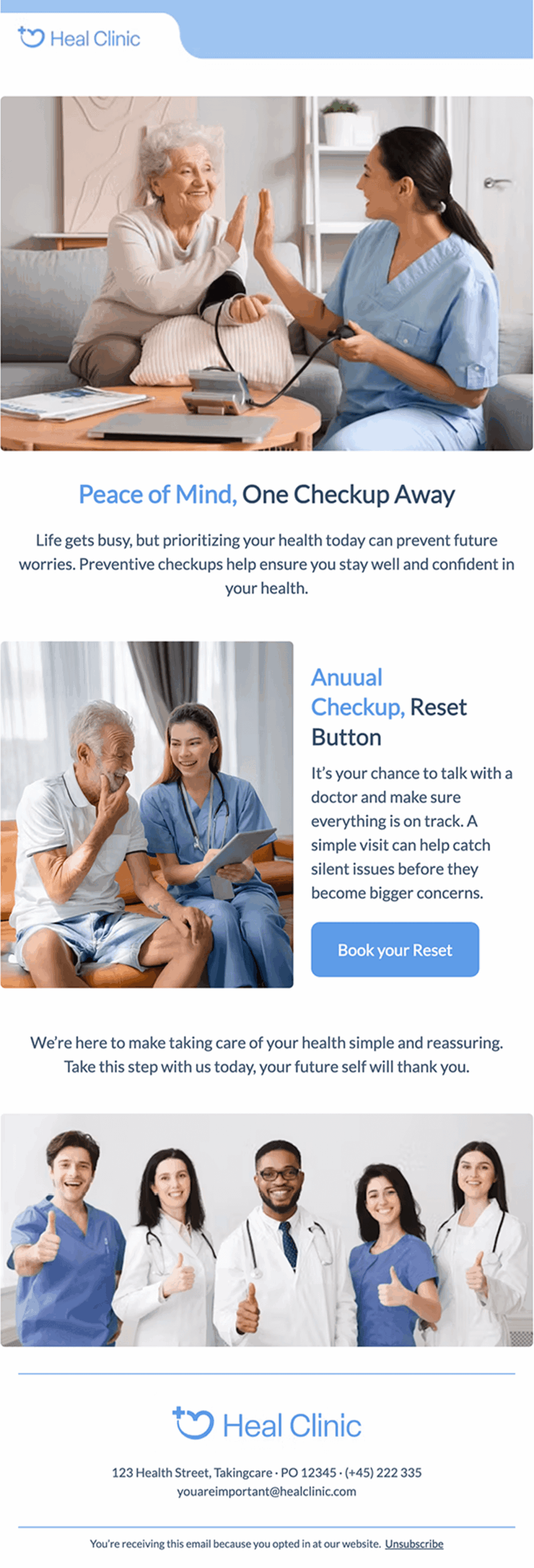
Now, to ensure a good level of accessibility for everyone:
- Use a single-column layout to increase readability on mobile devices.
- Keep font size at least 16px and choose high-contrast text colors (like dark gray on white).
- Avoid image-only emails as they may fail to load properly.
- Include alt text so screen readers can describe visuals.
- Make CTAs easy to tap. Your buttons should be at least 44×44 pixels and have clear labels.
- Use responsive templates that adjust to different screen sizes automatically.
- Limit the use of flashing elements or animations, which can trigger seizures or be distracting.
Further reading: Take a look at our email accessibility guide for more tips.
Set up automated workflows for common touchpoints
When someone subscribes to your list, downloads a resource, or books an appointment, they expect a timely response. However, for many healthcare teams, manual follow-ups are simply not realistic.
Email automation, in this case, will let you streamline the process and ensure that your recipients receive the right communications at the right time. This will not only keep them engaged but also help them get answers the moment they need them.
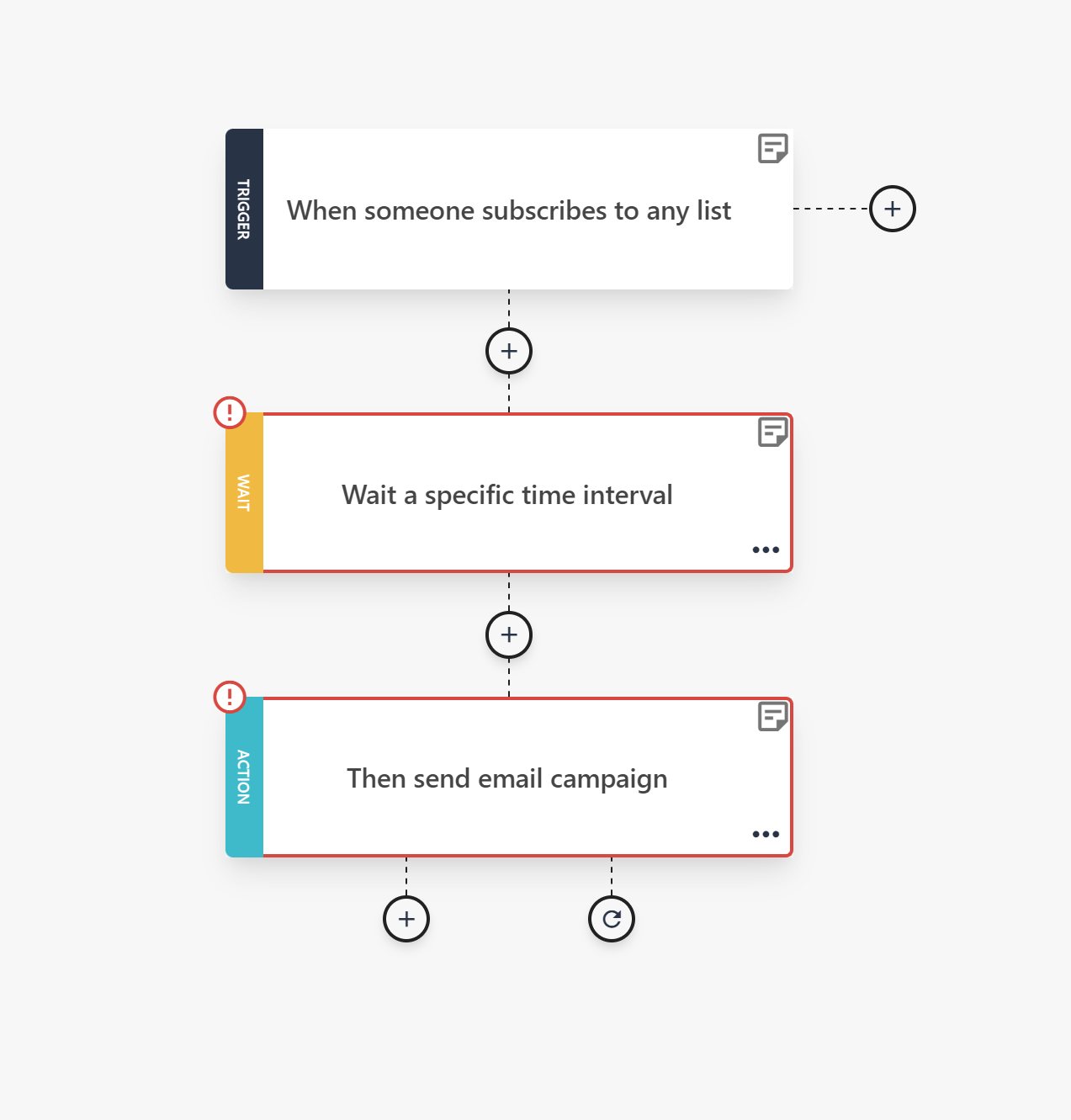
For example, you can use a welcome series to automatically send an email with helpful info or next steps after someone signs up for your newsletter.
You can even add more messages to your series to guide them through your services, introduce care providers, or share tips tailored to their health interests. This way, you’ll create a smoother patient experience from day one.
Have a consistent sending schedule
Timing matters more than ever in healthcare. That’s why you need a consistent email schedule.
- Appointments: send a reminder the day before.
- Urgent updates: deliver your emails as soon as possible to give patients enough time to act.
- Newsletters or check-up campaigns: aim for weekday mornings, especially between 8 and 9 AM, when open rates tend to be higher.
Additionally, regarding the best day to send, Thursday and Tuesday generally yield the best results, while weekends tend to see lower engagement.

That said, always test what works for your list and audience. Your best sending time may vary depending on the patient’s habits and the type of email you’re sending.
Monitor important metrics
To improve patient engagement, start by tracking key email marketing metrics like open rates, click-through rates, and email list growth.
These insights will help you understand what’s working and what needs improvement. Then, use A/B testing to compare subject lines, email content, or send times to optimize future campaigns.
By monitoring performance regularly and testing based on real data, you can send more relevant emails that drive better results.
Best Healthcare Email Marketing Tools
Not every email marketing platform is designed to meet the demands of the healthcare industry.
To ensure your patient communications are secure, here’s what a healthcare-friendly email marketing service should offer:
- HIPAA compliance and Business Associate Agreements (BAAs) to ensure protected health information (PHI) is handled securely and legally.
- End-to-end encryption to keep patient data safe and private.
- Role-based access to control who can access patient emails, templates, and data to minimize risk and human error.
- The platform should support preference centers, double opt-in, and customizable consent forms to collect communication details and comply with healthcare regulations.
- Automation features (like appointment reminders or follow-up series) with logic rules that help prevent accidental PHI exposure.
- Responsive templates that you can customize for your healthcare business.
Moosend
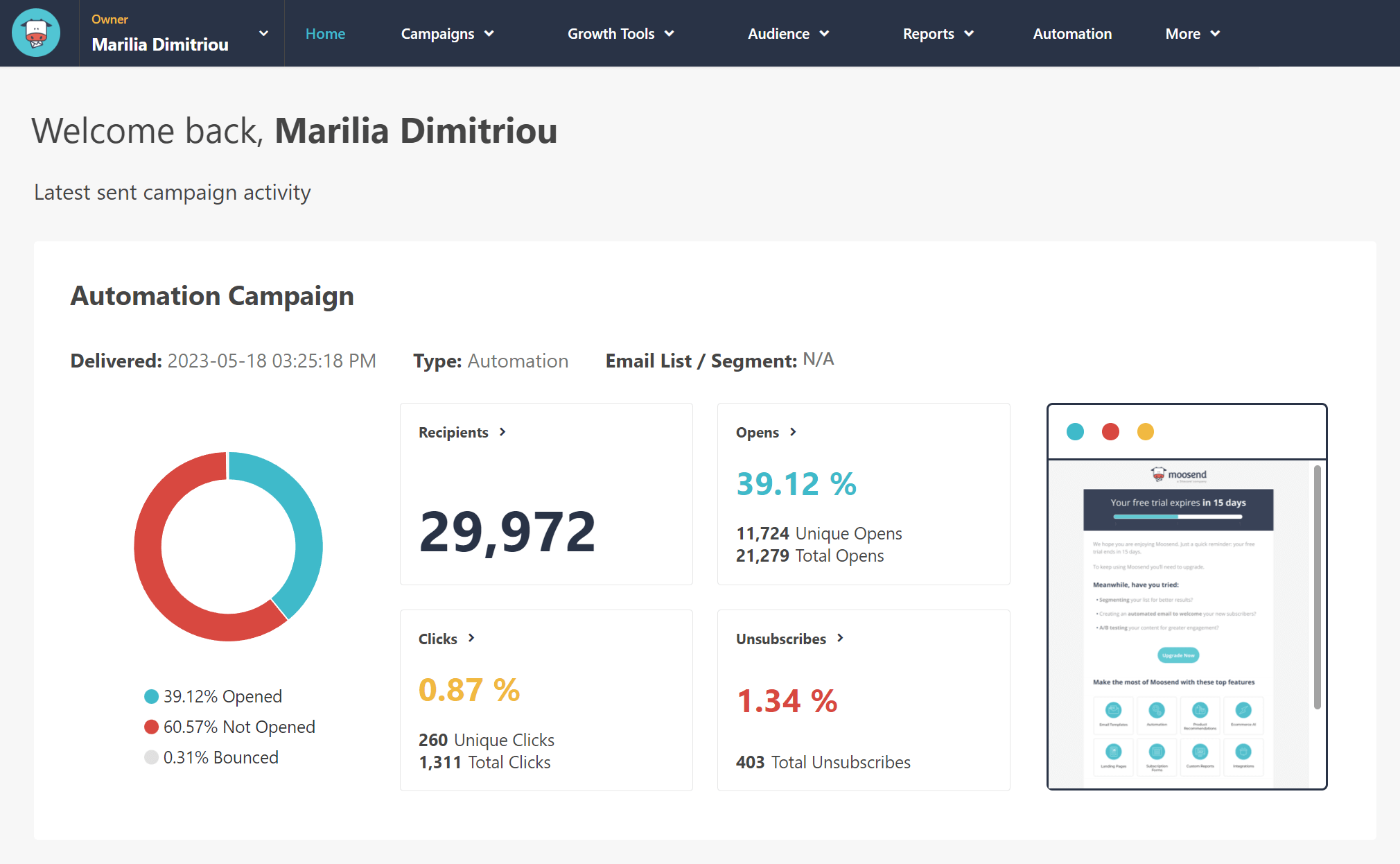
Moosend is a healthcare-friendly email marketing tool suitable for online pharmacies, wellness providers, clinics, and private practices that seek powerful automation features without a steep learning curve.
The service has received a third-party attestation from EY confirming that it meets key HIPAA requirements for logical and physical security, operational resilience, incident management, and change management.
This means healthcare businesses can confidently use Moosend as part of their HIPAA-compliant infrastructure, especially for campaigns that don’t involve PHI, such as newsletters, appointment reminders, and wellness content.
Best features
- Drag-and-drop email builder with mobile-responsive templates
- Behavioral automation (triggers based on sign-ups, page visits, etc.)
- GDPR-compliant forms and double opt-in support
- Real-time analytics and custom reports
- Security roles to give users different access rights
Pricing
Moosend’s Pro plan starts at $9/month for 500 subscribers and includes all core features, such as unlimited email sends and an SMTP server. For more advanced or specific needs, the Custom plan allows you to create a personalized feature set that meets your goals. Larger healthcare businesses can also opt for the Enterprise plan.
You can also try Moosend for free by signing up for the 30-day trial.
Constant Contact

Constant Contact supports HIPAA-compliant use cases only if you sign their standard Business Associate Agreement (BAA).
While they won’t customize the agreement, once signed, it allows healthcare providers to use the platform in accordance with HIPAA requirements, as long as no sensitive PHI (such as mental health, substance abuse, or HIV data) is included.
This makes Constant Contact a viable option for non-sensitive healthcare communications, such as appointment reminders, general follow-ups, or wellness updates.
It also offers robust data protection, including encryption, role-based access controls, and multi-factor authentication, along with reliable list management and segmentation tools.
Best features
- Standard BAA available upon request
- Email templates and automation
- Contact list segmentation
- Multi-user roles to limit internal access
Pricing
Paid plans start at $12/month with the Lite plan, which supports 500 contacts and offers basic email and social tools. The Standard plan costs $35/month and includes automation features to help streamline communication. For those needing advanced segmentation, reporting, and marketing capabilities, the Premium plan is available at $80/month.
You can try the platform by signing up for the 14-day free trial.
Amazon SES

Amazon Simple Email Service (SES) is a cloud-based email platform that healthcare providers can use to send secure transactional and marketing emails at scale. As part of the Amazon Web Services (AWS) ecosystem, SES can be configured to support HIPAA compliance when used within a HIPAA-eligible AWS account and under a signed Business Associate Agreement (BAA).
It’s best suited for tech-savvy healthcare teams or developers who need a flexible, API-powered solution for sending appointment confirmations, lab notifications, or system alerts without relying on a traditional email marketing interface.
Best features
- Integrates with other AWS tools for secure data storage, access management, and logging
- Highly scalable infrastructure ideal for high-volume senders
- Requires technical setup to ensure HIPAA compliance (including encryption, IAM roles, and logging)
Pricing
Amazon SES follows a pay-as-you-go model. You pay $0.10 per 1,000 emails sent or received, plus $0.12 per GB of attachments. New AWS users can get up to 3,000 message charges free each month for 12 months and receive $200 in AWS Free Tier credits.
Healthcare Email Marketing Made Easy
A strong email marketing strategy for healthcare begins with understanding what patients need, which includes timely updates, helpful content, and clear communication.
Once your strategy is set, the tools you choose will shape the results. HIPAA-compliant email platforms give you the foundation to protect sensitive data without losing marketing power. Add in smart automation, secure list management, and segmentation, and you’ll be able to deliver the right message at the right time.
Ready to put it into action? Start with a free Moosend account and discover how simple and secure email marketing can be for your healthcare brand.
FAQs
Below, let’s answer some common questions regarding healthcare marketing.
1. What does HIPAA compliance entail?
HIPAA compliance entails adhering to a set of rules designed to protect patients’ health information. This includes keeping data secure, limiting access to sensitive information, and using systems and vendors that also meet HIPAA standards, especially for any platform that stores or transmits patient data.
2. What happens if you use a non-HIPAA-compliant email service to send messages with PHI?
If you send emails containing protected health information (PHI) through a platform that isn’t HIPAA-compliant, you risk serious legal and financial penalties. It also compromises patient privacy and can damage your organization’s reputation.
3. What types of healthcare emails can I send without including PHI?
You can safely send general wellness tips, office updates, event invitations, and promotional content, as long as they don’t reference specific patient information or conditions. Always avoid including names, treatment details, diagnoses, or appointment specifics unless you’re using a HIPAA-compliant provider.
4. What is a BAA?
A Business Associate Agreement (BAA) is a legal contract between a healthcare provider and a vendor that handles PHI on their behalf. It ensures the vendor meets HIPAA requirements for safeguarding sensitive health data.
5. Is Mailchimp HIPAA compliant?
No, Mailchimp does not currently support HIPAA-compliant use cases and won’t sign a BAA. It’s not a suitable option for sending emails that involve PHI.
6. What other marketing channels can I use along with emails?
To enhance your healthcare marketing strategy, consider integrating email campaigns with social media channels, such as Facebook, Instagram, or LinkedIn. This cross-channel approach helps increase visibility, boost brand awareness, and reach patients where they’re most active.
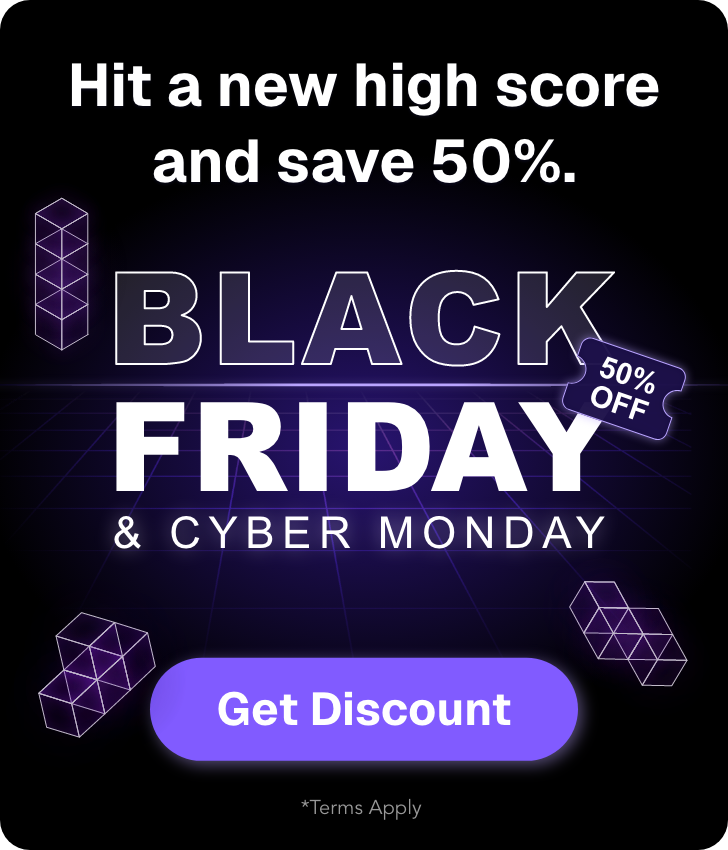


 Published by
Published by

 Published by
Published by
